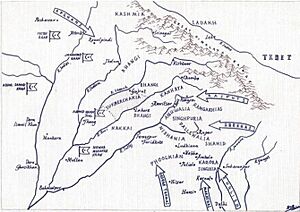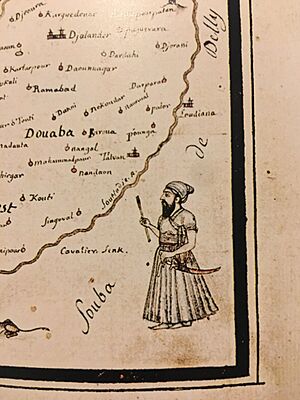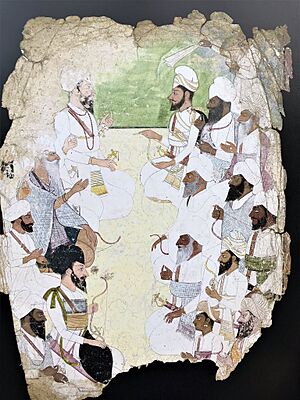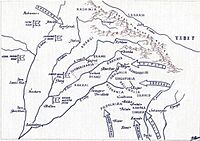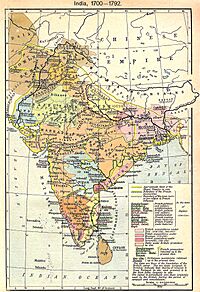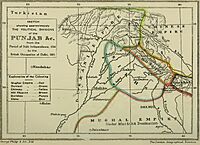Sikh Confederacy facts for kids
Quick facts for kids
Sikh Confederacy
Sikh Misalā
|
|||||||||||||
|---|---|---|---|---|---|---|---|---|---|---|---|---|---|
| 1748–1799 | |||||||||||||
|
Motto: ਅਕਾਲ ਸਹਾਇ
Akāl Sahāi "With God's Grace" |
|||||||||||||
|
Anthem: ਦੇਗ ਤੇਗ ਫ਼ਤਿਹ
Dēg Tēg Fateh "Victory to Charity and Arms" |
|||||||||||||
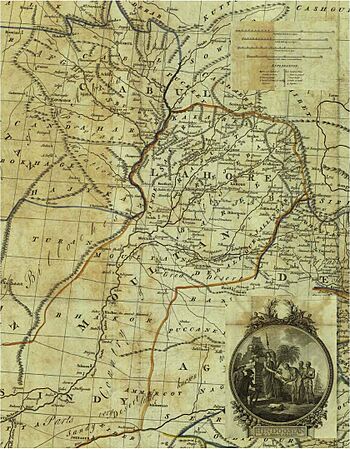
Map of the Sikh Confederacy (1782)
|
|||||||||||||
| Status | Confederacy | ||||||||||||
| Capital | Amritsar | ||||||||||||
| Language | Punjabi | ||||||||||||
| Religion | Sikhism | ||||||||||||
| Government | Aristocratic republican confederation | ||||||||||||
| Jathedar | |||||||||||||
|
• 1748–1753
|
Nawab Kapur Singh | ||||||||||||
|
• 1753–1783
|
Jassa Singh Ahluwalia | ||||||||||||
|
• 1783–1799
|
Naina Singh | ||||||||||||
| Legislature | Sarbat Khalsa | ||||||||||||
| History | |||||||||||||
|
• Passing of Gurmata to establish the Sikh Confederacy
|
29 March 1748 | ||||||||||||
|
• Ranjit Singh unites the Sikh Confederacy into the Sikh Empire
|
7 July 1799 | ||||||||||||
| Currency | Nanakshahi | ||||||||||||
|
|||||||||||||
| Today part of | India Pakistan |
||||||||||||
The Sikh Confederacy was a group of twelve independent states. These states, called Misls, came together in the 18th century. They were located in the Punjab region of the Indian subcontinent. The rise of the Sikh Confederacy helped weaken the Mughal Empire. This happened before Nader Shah's invasion of India in the late 1730s.
Contents
History of the Sikh Confederacy
How the Sikh Misls Formed
Sikh Gurus and their followers faced difficult times. To protect themselves, they created military groups. These groups fought against the Mughal Empire and local kings. Banda Singh Bahadur led this resistance for a while.
After some defeats, Sikhs hid in forests and hills. They organized themselves into small fighting groups called jathas. These groups were like small armies.
Later, in 1733–1735, these jathas formed a larger army. This army was known as the Dal Khalsa. It had two main parts: the Taruna Dal (Youth Brigade) and the Budha Dal (Elder Brigade).
In 1748, Sikh leaders met in Amritsar. They passed a special decision called a Gurmata. This decision reorganized the jathas into new groups called misls. Eleven misls were formed, and they created a united army called the Dal Khalsa Ji. Jassa Singh Ahluwalia was chosen to lead all the misls.
How the Misls Worked Together
The misls formed a kind of partnership. One traveler described it as an "aristocratic republic." This means it was led by powerful families or leaders. Even though some misls were stronger than others, they usually worked together. They cooperated when facing outside threats from other states.
The misls held meetings twice a year. These meetings were called the Sarbat Khalsa. They took place in Amritsar. During these meetings, they made important decisions for the whole Sikh community.
The Twelve Sikh States (Misls)
These are the twelve main states that made up the Sikh Confederacy:
| Name | Founder | Main Capital(s) | What Happened to Them |
|---|---|---|---|
| Phulkian | Phul Singh | Patiala, Nabha, Jind | Allied with the British; became princely states like Patiala. |
| Ahluwalia | Sadho Singh | Kapurthala | Allied with the Sikh Empire; later became the princely state of Kapurthala. |
| Bhangi | Chhajja Singh | Amritsar, Lahore | Conquered by the Sukerchakia Misl, which then formed the Sikh Empire. |
| Kanhaiya | Jai Singh | Sohian | Joined the Sikh Empire. |
| Ramgarhia | Jassa Singh | Sri Hargobindpur | Joined the Sikh Empire. |
| Singhpuria | Khushal Singh | Jalandhar | Parts joined the Sikh Empire, other parts joined the British. |
| Panjgarhia | Karora Singh | Shamchaurasi, Hariana | Parts joined the British; other parts joined the Sikh Empire. |
| Nishanwalia | Dasaundha Singh | Ambala, Shahbad Markanda | Parts joined the British Raj and parts joined the Sikh Empire. |
| Sukerchakia | Charat Singh | Gujranwala | This Misl grew to form the powerful Sikh Empire. |
| Dallewalia | Gulab Singh | Rahon | Joined the Sikh Empire. |
| Nakai | Heera Singh | Chunian | Joined the Sikh Empire. |
| Shaheedan | Baba Deep Singh | Shahzadpur | Joined the Sikh Empire. |
Military Power of the Misls
Each Misl had its own army. Soldiers were loyal to their Misl's leader. A Misl could have a few hundred to tens of thousands of soldiers. Soldiers could choose which Misl to join. They could even switch Misls if they wanted.
The leaders of the Misls, called Barons, would combine their armies. They did this to defend against common enemies. These orders were usually given when there were big threats, like attacks from Afghanistan. After a battle, any gains were shared among the Misls. This was based on how much each Misl helped.
The Sikh Confederacy had a special way of organizing its military. They mainly used light cavalry, which are soldiers on horseback who move quickly. Each cavalryman had to bring their own horse and weapons. They usually carried a spear, a type of gun called a matchlock, and a curved sword (scimitar).
Soldiers were often paid every six months, after the harvest. This was called the 'Fasalandari' system.
Clever Cavalry Tactics
The Sikh Misls were known for their fast and smart fighting style. They were like guerrilla armies, but much larger. They mostly used cavalry and had less heavy artillery than other armies of their time. Because of this, they avoided big, open battles.
Instead, they used quick attacks and retreats. Cavalry units would attack, then pull back to reload their guns, and then attack again. This tactic was very effective. They would also try to get around the enemy, block river crossings, cut off supplies, and attack smaller enemy groups. They used "hit-and-run" tactics to wear down larger armies.
One special tactic was the Running Skirmish. It needed great skill from the Sikh cavalrymen. Writers from that time, like George Thomas, described it. A group of about 40-50 horsemen would ride close to the enemy. They would stop quickly, fire their guns, and then retreat about 100 paces. They would reload while moving back and then repeat the attack. Their horses were trained to stop instantly from a fast gallop.
How the Misls Were Governed
The Sikh Misls had different ways of managing their land. These were called the patadari, misaldari, tabadari, and jagirdari systems. When land was given out, the person who received it was responsible for keeping law and order there. The land directly controlled by the Misl chief was called sardari.
The patadari and misaldari systems were the main ways Misls were set up. The tabadari and jagirdari systems were used after a Misl gained a lot of new land. The system used depended on how important the local leader (sardar) was to the Misl.
Patadari System: Sharing the Land
The Patadari system was used for newly taken lands. It involved leaders of small cavalry groups called surkundas. The Misl chief would take their share of land. Then, they would divide the rest among their main leaders (Sardars). The amount of land a Sardar got depended on how many cavalrymen they brought to the Misl.
These Sardars would then divide their land among their surkundas. Finally, the surkundas would divide their land among their individual cavalrymen. If a surkunda received land with towns, they had to build forts and set up rules for the people living there. Land in this system could not be sold, but it could be passed down to family members. Soldiers who got land this way owned it completely.
Misaldari System: Independent Allies
The Misaldari system was for leaders with a small number of cavalrymen. It also applied to independent groups of cavalrymen who chose to join a Misl. These groups kept the land they owned before joining the Misl. The leaders of these groups, called misaldars, could even switch their loyalty and land to another Misl without being punished.
Tabadari System: Loyal Servants
The Tabadari system was for land controlled by a Misl's tabadars. Tabadars were like loyal followers or retainers. They had to serve as cavalrymen for the Misl and were under the Misl's leader. They received land as a reward. However, their ownership of the land depended entirely on the Misl's leader. These land grants were only passed down to heirs if the Misl chief allowed it.
Jagirdari System: Wealthy Land Grants
The Jagirdari system involved giving out special land grants called jagirs. The Misl chief gave these jagirs to relatives, close followers, or people who had done great service. The owners of jagirs were also under the Misl's chief. Their ownership depended on the chief's needs.
Like tabadars, jagirdars had to provide personal service when the chief asked. But because jagirs were larger and brought more money, jagirdars had to use that money to equip and support a certain number of cavalrymen. This number depended on the size of their jagir. Jagirdari grants were usually passed down in families, but a Misl chief could take them back from an heir. When a tabadar or jagirdar died, their land would usually go back to the direct control of the chief.
Rakhi System: Protection Payments
The Rakhi system was a way the Dal Khalsa earned money. It was a system where people paid for protection. In the 18th century, it was a big source of income for the Sikh Misls.
Where the Misls Were Located
The Misl territories were mainly divided into two areas. These were the Malwa region and the Majha region. Most of the eleven Misls were located north of the Sutlej river. However, one Misl, the Phulkian Misl, was south of the Sutlej.
Sikhs living north of the Sutlej river were called Majha Sikhs. Those living south of the Sutlej river were known as Malwa Sikhs. There were also smaller groups of Sikhs in other areas, like the Dhanigeb Singhs and the Gujrat Singhs.
Sikh Women in Leadership
Many Sikh women played important roles in state affairs during this period. They were often part of royal families or Misl leadership. Here are some notable examples:
- Mai Fateh Kaur (died 1773) of Patiala Sikh dynasty
- Mai Desan Kaur (died 1778) of Sukerchakia Sikh Misl
- Bibi Rajinder Kaur (1739–1791) of Patiala Sikh dynasty
- Mai Sukkhan Kaur (ruled 1802) of Bhangi Sikh Misl
- Mai Lachhmi Kaur of Bhangi Sikh Misl
- Rani Sada Kaur (1762–1832) of Kanhaiya Sikh Misl
- Bibi Rattan Kaur of Dallewalia Sikh Misl
- Mai Karmo Kaur of Nakai Sikh Misl
- Bibi Sahib Kaur (1771–1801) of Patiala Sikh dynasty
- Maharani Datar Kaur of Sikh Empire (maiden name Raj Kaur of Nakai Misl) (1784–1838)
- Rani Aus Kaur (1772–1821) of Patiala Sikh dynasty
- Maharani Jind Kaur (1817–1863) of Sikh Empire
- Bibi Daya Kaur (died 1823) of Nishanwalia Sikh Misl
- Rani Desa Kaur Nabha of Nabha Sikh dynasty
- Bibi Khem Kaur Dhillon Of Sikh Empire
- Maharani Chand Kaur (1802–1842) of Sikh Empire
See also
- Dal Khalsa, the military forces of the Sikh Confederacy
- History of Punjab


